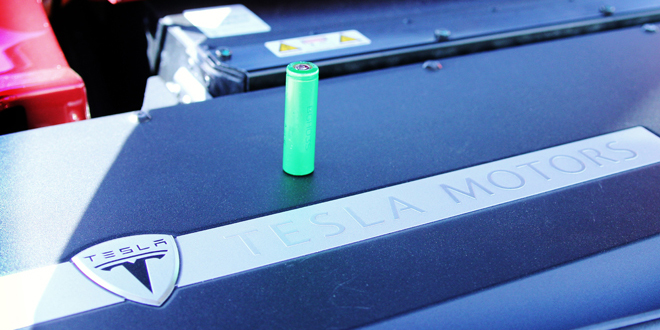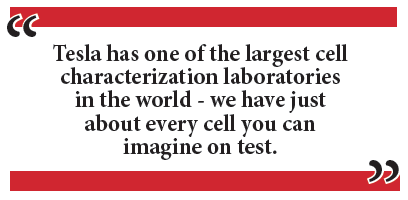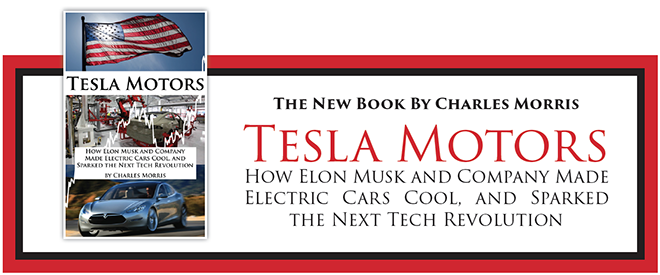This article is an excerpt from Tesla Motors: How Elon Musk and Company Made Electric Cars Cool, and Sparked the Next Tech Revolution by Charged Senior Editor Charles Morris.
Tesla seems to make a point of doing things differently than other automakers, and its battery pack – the most critical component of any EV – is a prime example. While every other major EV maker has chosen to develop its own large-format battery cells, when the Seers of Silicon Valley developed the Roadster, they chose a small-format battery that was already being used in huge quantities for laptops and other electronic gadgets.
This may have seemed like a homemade hack at the time, but it later came to be seen as a prescient move. Competitor Fisker’s dependence on a fellow startup, A123, as its sole battery supplier caused it some anxious moments. When a manufacturing defect caused A123 to recall a batch of batteries, Fisker risked a costly production delay. Tesla’s batteries are a tried-and-true format that’s readily available from Panasonic and other experienced and well-capitalized corporate giants, so the risks of any shortage are minimal.
Given Tesla’s ongoing success, it’s puzzling that no other automaker has followed its lead in the battery department – they all continue to use proprietary large-format cells.

Photo courtesy of Arnold de Leon/Flickr
When Tesla designed the Model S, which, unlike the Roadster, would be engineered in-house, using few or no off-the-shelf components, many assumed the company would ditch the little cylindrical cells, and develop a large-format flat cell similar to what GM and Nissan were using for their EVs.
Wrong again – Tesla opted to stick with the 18650 small-format cells. It wasn’t just the convenient size. Panasonic’s nickel-based lithium-ion chemistry yielded the highest energy density available in a production product, the cells were durable and long-lasting, and the company had many years of experience with the manufacturing process, which kept costs low and reliability high. However, Tesla did work with Panasonic to develop an improved version.

Sources: Nissan LEAF, Chevrolet Volt, Tesla Model S
In January 2010, the two companies announced that they would collaborate to develop next-generation automotive battery cells, which JB Straubel said would be optimized for use in EVs, and would be “the highest-energy density EV battery packs in the world.” In October 2011, the two companies finalized a supply agreement that called for Panasonic to supply Tesla with enough cells to build 80,000 vehicles over the next four years.

Aside from their size and shape, the cells used in Model S are unique, but some superficial observers continue to insist that they are “laptop batteries,” which Straubel seems to find a bit irritating. “For the immediate future we see 18650 as the most compelling,” he told the Society of Automotive Engineers (SAE) in 2013. “Believe me, we challenge it constantly. It always ends up being very controversial, for reasons I don’t totally understand. Nobody gives a damn about the shape and size of your fuel tank! But for some reason the shape and size of what you put your chemicals in to carry your energy in an EV is super-controversial. What people should really debate is the nature of the chemicals inside – that’s what determines the cost and performance.”
“At this point we really have heavily customized that cell. We’ve totally custom-engineered that cell, working jointly with Panasonic to create…an automotive cell, tested to automotive standards. It doesn’t go into laptops anywhere. What keeps us in that general shape and size is the production and cost efficiency. We’re seeing price points that none of the larger-format cells are able to meet.”
Naturally, Tesla is always on the lookout for new and improved battery technology. In fact, it’s widely believed that they are pretty far along. Next-generation batteries have already been demonstrated in the laboratory by several separate teams of researchers, and it would be strange if Tesla wasn’t already testing them at this point. However, as of this writing, the company has made no announcement as to when an upgrade might be introduced. Tesla Product Planner Ted Merendino told me back in February 2013 that it would probably be about five years hence.

Range, range, range! That’s what the mainstream press harps on in any story about EVs, and the EV media also tends to focus on the quest for a better battery, breathlessly reporting every discovery of a new chemistry that could yield more energy density (the term “Holy Grail” gets tossed around a lot). However, capacity isn’t everything – other factors may be even more critical, as Merendino told me. “Tesla has one of the largest cell characterization laboratories in the world – we have just about every cell you can imagine on test. Energy density is one attribute that we’re looking at, but we’re also looking at durability, reliability, susceptibility to heat, discharge/recharge cycles – hundreds of different attributes that make the best cell for automotive use, not the least of which is price and availability in the marketplace. We don’t want to get into a situation where we’re dependent on one supplier.”
JB Straubel made a similar point in his interview with the SAE. “The first question we ask when we meet a new cell company is, show us your cost roadmap. Nobody wants to talk about cost – they always leave that to the end of the discussion. That’s silly. For EVs, there are some key safety and performance metrics that are foundational. They have to be there. Beyond that the most important thing is cost efficiency of energy storage. So if anyone has a more cost-efficient cell architecture, we’d be all ears. Right now nobody has proven they have a more cost-effective cell architecture than ours.”

In May 2014, that still seemed to be the case, as Elon Musk said that while new developments on the battery front were being announced almost daily, “We have yet to see even a single example…of a cell working at the laboratory level that is better than the one that we have, or the ones that we expect to come out with.” Now, the way I parse this statement, he isn’t saying that there’s no improved battery technology in the offing – on the contrary, he’s saying that Tesla will be the one to develop it. Musk and his merry men are masters at managing expectations for fun and profit, so just because Tesla has been playing down the possibility of a new magic battery doesn’t mean they don’t have one waiting in the wings, ready to be tweeted out on a slow news day.
A rumor that Tesla is working on a new type of hybrid pack that combines two different battery technologies to deliver a huge increase in range floated around the discussion groups in late 2013, and several outlets reported it as breaking news after a couple of stock analysts discovered the story (as TSLA set a new record, flirting with $200 a share for the first time).
Tesla has filed at least eight patents on applications of metal-air battery technology, as Green Car Reports’ John Voelcker reported in April 2013. One of these, “Efficient Dual Source Battery Pack System for an Electric Vehicle,” envisions two battery packs working together. An extract from the application:
A method of optimizing the operation of the power source of an electric vehicle is provided, where the power source is comprised of a first battery pack (e.g., a non-metal-air battery pack) and a second battery pack (e.g., a metal-air battery pack).
The power source is optimized to minimize use of the least efficient battery pack (e.g., the second battery pack) while ensuring that the electric vehicle has sufficient power to traverse the expected travel distance before the next battery charging cycle.
Metal-air batteries have high energy density but low power density, while lithium-ion batteries offer the reverse, so a hybrid system could theoretically leverage the strengths of both to maximize range and performance.
Ultracapacitors, which feature virtually unlimited cycle life and great power density, could theoretically also be added to the mix (remember that Musk planned to study ultracapacitors at Stanford back in ancient times). This idea parallels the paradigm of tiered computer storage, which employs expensive but fast cache memory, cheaper RAM and super-cheap high-capacity hard drives.
All of this was (and is) mere speculation, but it seemed particularly relevant at the time – the same week, a GM exec acknowledged that automakers are “in a race” to develop better batteries.
That race continues. Nissan recently announced that it plans to be “pragmatic” about obtaining the best and cheapest batteries available, whether that means producing them at its own battery plants, or buying them from an outside supplier such as LG Chem. Rumor has it It’s now confirmed that the Korean battery behemoth will be providing the batteries for GM’s vaunted 200-mile EV when it hits the market in a couple of years.

The Quest for the Grail is surely bound up with the development of the Gigafactory. Several EV-watchers have opined that, in order to deliver Model 3 at the desired price point, Tesla will need to make a battery breakthrough. When the Gigafactory finally comes online, it’s a safe bet that it won’t be producing the same battery cells that are powering today’s Model S.

Battery technology is just one of the things that make Model S such an amazing automobile. Charles’s new book also includes lengthy quotes from Tesla Chief Designer Franz von Holzhausen on the advantages of designing an EV from the ground up, and from Tesla founder Ian Wright about the company’s unique systems approach to vehicle software. For more information, see www.teslamotorsbook.com.



















































